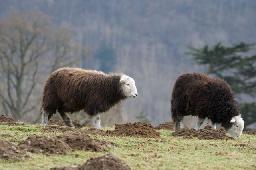
Stats
Work interests: research, editing, science communication
Affiliation/website: National Museum of Ethnology, Osaka
Preferred contact method: Any
Preferred contact language(s): English, German
Contact: email = researchcooperative-at-gmail-dot-com
Favourite publications: Various, and especially the open access versions of older journals with effective review systems
Founding Member
Affiliations: 1996-present: National Museum of Ethnology, Osaka. 1995: Freelance editor, Kyoto. 1994: JSPS Research Visitor, Kyoto University, Kyoto. 1993: Research Visitor, Australian National University, Canberra. 1991: Visiting Researcher, National Museum of Ethnology, Osaka.1990: STA Fellow, National Institute for Ornamental Plants, Vegetables, and Tea (NIVOT), Ano, Japan
Contact: National Museum of Ethnology, Senri Expo Park, Suita City, Osaka, Japan 565-8511
Biographical: Established the Research Cooperative in 2001
Favourite Publications: Various
The Shepherd's Life: A Tale of the Lake District

Book review: The Shepherd's Life: A Tale of the Lake District , by James Rebank (2016 , Penguin Books, UK).
Peter J. Matthews, for The Research Coooperative, blog, 6th May 2019.
The Lake District of northern England is most famous today as a scenic destination for millions of tourists annually, a get-away-from-it-all region for visitors from across the United Kingdom and the world. It is mountainous, with many peaks of more than 600m, including the highest peak in England, at 978m. These are not high mountains by world standards, but at a latitude of around 54 degrees North, the entire region is very cold in winter, has short summers, and is not easy for farming.
It is in this region that James Rebanks grew up as a farmer and shepherd, like his parents and grandparents and others before them. While telling the story of his own family, and the tensions, tenderness and cooperation that coexist in a multi-generational family farm, Rebanks also tells the larger story of a traditional farming system that has existed for thousands of years, based on sheep herds that may have originated with the migrations of Vikings into the region from northern Europe. There is also a story here of modern social history, telling how landless peasants became tenant or smallholding farmers while also retaining access to high mountain pastures (the fells) that are still managed as commons, having escaped enclosures (privatisation) during and after the 19th century.
The author also shows how traditional "cultural landscapes" and "intangible cultural heritage" are formed, and how these may struggle to survive even as efforts are made to preserve the outward, material appearances of a landscape. To understand his own world, Rebanks stepped outside, into the world of academic study, and then returned. Rebanks is quite explicit in his own wish to dedicate his life to a particular place and culture, while helping others to do the same in other regions of the world, through various kinds of negotiation with the modern world. He is anti-dogmatic, despite his dedication to a particular way of life: his purpose is not to prescribe solutions, but to help others find their own solutions, and to enjoy their own ways of living. The stories in this book are both personal and universal, and I could easily find resonances with my own experiences of life growing up in New Zealand, where my ancestors were farmers, and where some branches of the family remain close to a particular landscape and rural culture, while others have wandered far from it.
Perhaps it is my own farming instincts and family history that made this book so interesting for me, but I also want to think about the implications for my work as an ethnobiologist. For many years I have been looking at how people across Asia and the Pacific have maintained certain plants, cultivation methods, and cooking methods over thousands of years, not only across generations but also across cultures and languages. Although we often think of the world as divided by geographical, social, and cultural boundaries, there are also many continuities across ancient cultural landscapes. Understanding such continuities may help us to recognise shared interests in the present, and opportunities for mutual support in the future.
[See also: The Illustrated Herdwick Shepherd , by the same author].
Photo above: "Herdwick sheep browsing in a field remarkably popular with moles", by Pete Birkinshaw , 19th February, 2009 (via Wikimedia Commons and licensed under the Creative Commons Attribution 2.0 Generic license).











